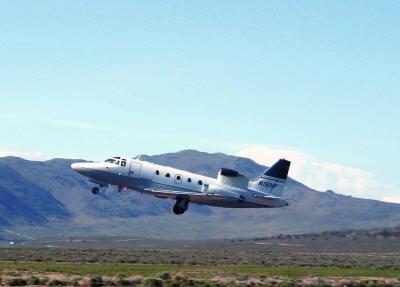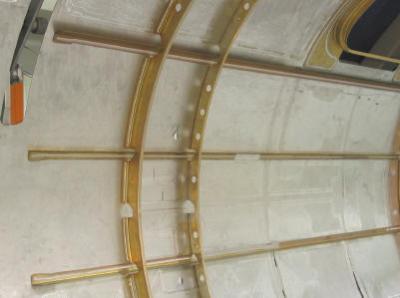Thu, Jun 06, 2002
As Personal Jet's First Flight Approaches, Engine Takes to
Skies

Eclipse Aviation has just let us know that on May 30, 2002, the
Williams EJ22 turbofan engine, the revolutionary small jet engine
that was designed expressly for the Eclipse, successfully completed
its first flight. Performing flawlessly, the EJ22 flew for
approximately 50 minutes mounted onto its flying test bed, a
modified Sabreliner Model 60. The EJ22 is being developed
exclusively for Eclipse Aviation by Williams International of
Walled Lake, Michigan. Two EJ22 engines will power the
next-generation Eclipse 500 jet. Each engine weighs approximately
85 lbs. and produces 770 lbs. of thrust, the highest
thrust-to-weight ratio of any commercial turbofan ever
produced.
"This is truly a momentous occasion," said Vern Raburn, president
and CEO of Eclipse Aviation. "We congratulate and applaud the
people of Williams International for this great achievement.
Together, each day we draw closer to realizing our dream of
changing the way people travel."
In this maiden flight, the EJ22 completed the entire flight
envelope planned for the first flight of the Eclipse 500 jet,
scheduled to occur later this summer.
The flying test bed was designed to test the capabilities of the
EJ22 in flight including FADEC software development, relight
characteristics and operating envelope. EJ22 testing on the flying
test bed will continue for several months through which valuable
information about the characteristics of the engine will continue
to be collected, even after the inaugural flight of the Eclipse 500
jet.
The EJ22 is the commercial version of the FJX-2 technology
demonstration engine that Williams International developed jointly
with NASA's General Aviation Propulsion program.
More Good News: Friction-Stir Welding Gets FAA's OK

Eclipse also tells us that the FAA has approved the friction
stir welding process specification created for use in the assembly
of the Eclipse 500 jet.
Eclipse is the first to use this advanced manufacturing technology
in production of thin-gauge aircraft aluminum. This approval was
received approximately one year ahead of the anticipated
schedule.
FAA approval of this process specification, in conjunction with the
receipt of the Eclipse 500 type certificate, will allow Eclipse
Aviation to build production aircraft using friction stir
welding.
The friction stir welding process specification details the
procedural requirements, quality assurance provisions, standards
for tooling and material preparation necessary for the use of
friction stir welding in the assembly of aircraft.
Friction stir welding will replace more than 60 percent of the
rivets on major assemblies of the Eclipse 500 jet including the
cabin, aft fuselage, wings and engine mounts. Friction stir welding
is highly automated and significantly faster than other structural
jointing processes.
It enables the drastic reduction in aircraft assembly time and
eliminates the need for thousands of rivets resulting in reduced
assembly costs, better quality joining and stronger, lighter
joints.
More News
Also: Dream Chaser, Newark Airport, Drone Operator Sentenced, Airbus H225 Buy US President Donald Trump recently vowed to declassify all files related to legendary aviator Amelia E>[...]
Receiver Autonomous Integrity Monitoring (RAIM) A technique whereby a civil GNSS receiver/processor determines the integrity of the GNSS navigation signals without reference to sen>[...]
Airplane Continued To Bank To The Right And “Went Straight Down Into The Hillside At What Sounded Like Full Engine Power.” On September 12, 2025, about 1421 Pacific day>[...]
Get The Latest in Aviation News NOW on Instagram Are you on Instagram yet? It's been around for a few years, quietly picking up traction mostly thanks to everybody's new obsession >[...]
From 2009 (YouTube Edition): Leading Air Show Performers Give Their Best Advice for Newcomers On December 6th through December 9th, the Paris Las Vegas Hotel hosted over 1,500 air >[...]
 Airborne 09.29.25: Amelia Declassified, AV-30 Upgrades, Who's Hiring Pilots?
Airborne 09.29.25: Amelia Declassified, AV-30 Upgrades, Who's Hiring Pilots? ANN's Daily Aero-Term (10.03.25): Receiver Autonomous Integrity Monitoring
ANN's Daily Aero-Term (10.03.25): Receiver Autonomous Integrity Monitoring NTSB Prelim: Lawson Thomas O Lancair Super ES
NTSB Prelim: Lawson Thomas O Lancair Super ES ANN FAQ: Follow Us On Instagram!
ANN FAQ: Follow Us On Instagram! Classic Aero-TV: ICAS Perspectives - Advice for New Air Show Performers
Classic Aero-TV: ICAS Perspectives - Advice for New Air Show Performers




